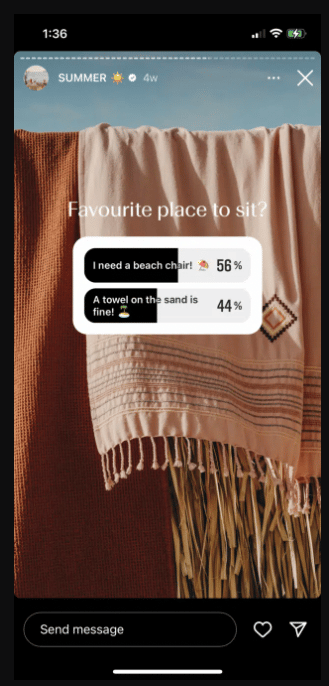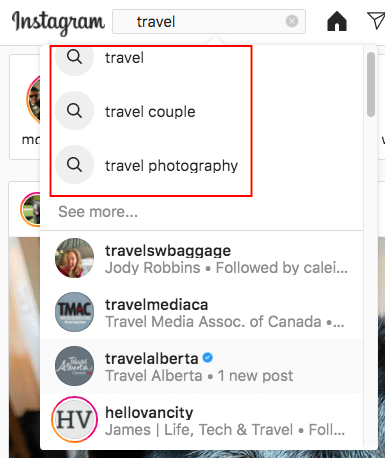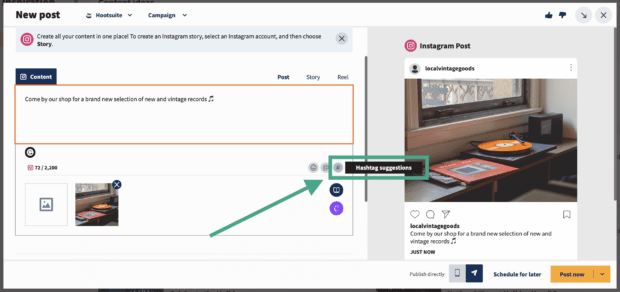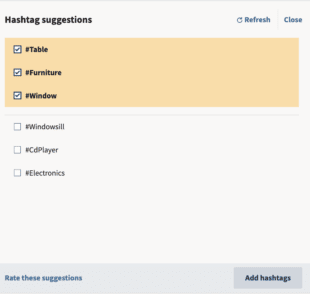The Easiest Social Media Optimization Techniques to Try Now
Social media optimization (SMO) helps business owners, content creators and social media marketers get the most out of their social media presence.
Understanding how to optimize your profiles and posts for maximum returns might sound scary, but we’ve put together a list of simple tactics that don’t involve complicated keyword research or require technical know-how.
Read on to find out how to:
- Improve your brand’s visibility on social media platforms
- Get more engagement on your posts
- Increase website traffic from your social profiles
- Make more sales from social media
- And more!
Bonus: Get a free social media strategy template to quickly and easily plan your own strategy. Also use it to track results and present the plan to your boss, teammates, and clients.
What is social media optimization?
Social media optimization is the process of improving your social posts (or your whole social media strategy) to achieve better results: faster follower growth, higher levels of engagement, more clicks or conversions, etc.
Social media optimization can involve many different techniques and tactics that vary in scope and complexity, such as:
- Basic improvements on an individual post level, e.g. asking an engaging question in a post caption or picking a more thumb-stopping visual
- High-level improvements, e.g. redefining your brand’s tone of voice on social media
In any case, social media optimization should be based on performance analysis, audience and competitor research and/or insights gathered through social listening.
Think of SMO as an opportunity for you to analyze and adjust what you’ve been doing on social media to make it perform even better.
Benefits of social media optimization
Here’s what the right social media optimization tactics can do for your social media efforts:
- Grow your followers at a faster rate
- Understand your audience on a deeper level
- Increase brand awareness on social media
- Improve reach on social media
- Improve the quality of your leads from social media
- Sell more of your products and services through social channels
- Increase your engagement rate
5 social media optimization areas (and techniques to improve them)
To the untrained eye, a brand’s social media presence might seem effortless, but there’s a lot that goes on behind the scenes to ensure that social media accounts are being used as effectively as possible.
There are 5 key areas of your social strategy to focus on optimizing with different techniques:
- Engagement
- Follower growth
- Conversions
- Accessibility
- Overall performance
Read on to find out how best to optimize for each category.
1.Optimize for better engagement
Post at the right times
To get anywhere on social, you need to consistently post high-quality content that your audience likes. But did you know you also need to post it at a time when your audience is more likely to engage with it?
That’s right. There are certain times of the day and week that your audience is more likely to be online — and more likely to heart your content or respond with a comment.
Figuring out those special times to post on social media is hard work. Especially when audience habits vary from industry to industry.
We’ve done some research to determine some universal best times to post on social media, but it should only be used as a general guide. What works for your social media pages and your audience might be different.
That’s where a social media scheduling tool that recommends best times to post for your unique audience comes in. We might be biased, but we like Hootsuite’s tool best for a couple of reasons:
- Gives timing recommendations based on your historical performance and goals: extend reach, build awareness, increase engagement
- Gives unique timing recommendations per network
- Shows data in an easy-to-understand heatmap
- Can find it in your analytics dashboard and in the publisher (where you’re already creating posts)
- Makes recommendations every time you schedule a post
Hootsuite’s Best Time to Publish feature recommends optimal times to post on each of your social networks
Ask questions in your posts
There’s no easier engagement hack than to ask your followers questions and have them comment with their responses. The trick is, though, to only ask interesting questions that your audience would actually care to answer.
Try using a question sticker in an Instagram story, run an informal poll, or simply pose some food for thought in your caption.
Turn your post into a carousel
Carousel posts are one of the most engaging formats brands can use on the platform. Hootsuite’s own social media team finds that, on average, their carousel posts get 1.4x more reach and 3.1x more engagement than regular posts on Instagram. Results are similar on other networks that allow carousels as well, like LinkedIn, Facebook, and Twitter.
The temptation to swipe left, it seems, is hard to resist — especially when there’s a persuasive cover slide.
Post the right amount
Bombarding your followers with too much content is a surefire way to tank your engagement rate. On the other hand, finding your optimal social media posting schedule is essential to driving more engagement and conversations with your brand.
Here’s how often you should post to the biggest social media networks, according to experts:
- On Instagram, post between 3-7 times per week.
- On Facebook, post between 1 and 2 times a day.
- On Twitter, post between 1 and 5 Tweets a day.
- On LinkedIn, post between 1 and 5 times a day.
Remember that finding the sweet posting spot might take some time. Experiment and find what cadence works best for you.
2. Optimize to get more new followers
Add SEO to your bio
Your social media bio is one of the first things a new visitor or potential lead sees when visiting your profile page. So, it’s essential to have this as polished as possible.
Important information to always include in your social media profiles:
- Who you are
- What your business does
- What you do
- The topics that interest you
- Your brand’s tone (more on this below!)
- How someone can get in touch with you
Your bio is also a chance for you to state why someone should even consider following you. Take Hootsuite’s social media bio for example.
We say we’re the “global leader in social media management” on all our platforms. If you work in social media, it’s clear why we think you should follow us. 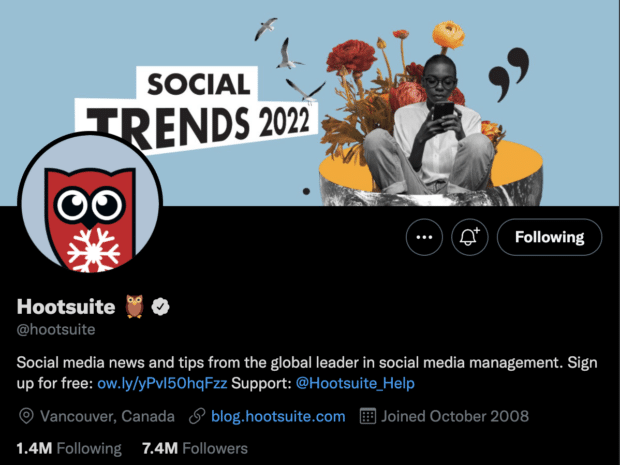

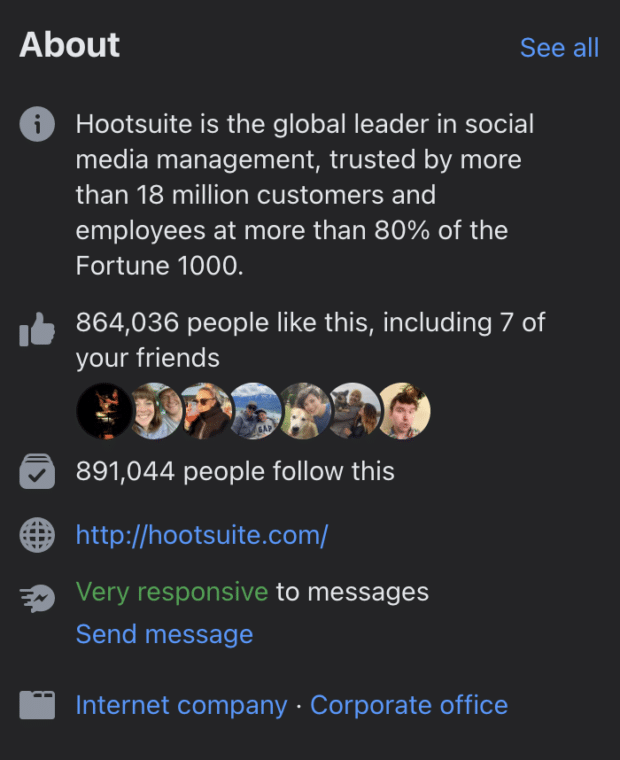
But including all this info in your bio isn’t just important for communicating with people who have already landed on your profile. It’s important to help new people find your profile through social media search engines too.
Make sure your bio includes relevant keywords you think your audience will be searching for when looking for your product or service on social. For example, if you’re a travel company, make sure to include the word “travel” in your social media bios (or even your name). [contentugprade variant=popup]
Here are some more tips to make sure your bio is optimized for SEO:
- Include your location
- Include your primary keyword in your username (i.e., “@shannon_writer”)
- Include hashtags you use frequently or branded hashtags your business has created
Read more tips for SEO on Instagram, specifically.
Include relevant keywords in your captions
Gone are the days of the one-word caption.
Several social media platforms, including Instagram, now specifically recommend including relevant keywords in post captions to help with discoverability. That means the more you write, the more your post is likely to show up in social search results.
This is great news for lesser-known brands, since it gives people a better chance to find your content without searching for your specific account name.
A keyword results page for “travel photography” on Instagram
But don’t just write a novel stuffed with keywords. It’s gotta be relevant to the image or video you’ve posted or your human readers will know it’s spammy.
So, how do you choose your target keywords?
Analytics tools will give you more insight. For example, use Google Analytics to see which keywords are driving traffic to your website. These are likely good candidates to test in your Instagram posts.
Add relevant hashtags to your posts
Marketers have been using and abusing hashtags for many years (who among us hasn’t tried hiding 30 hashtags in the comments of their Instagram post?). But in 2022, Instagram revealed some best practices for using hashtags to help people discover your content on the platform through search, even if they aren’t following you yet.
- Put your hashtags directly in the caption
- Use only relevant hashtags
- Use a combination of well-known, niche, and specific (think branded or campaign-based) hashtags
- Limit hashtags to 3 to 5 per post
- Don’t use irrelevant or overly generic hashtags like #explorepage (this might get your post marked as spam)
Even though these tips come from Instagram, you can consider them best practices for all social networks. Almost every platform has published similar advice.
See more hashtags best practices:
But wait, does the idea of coming up with the right hashtags for every single new post sound daunting?
Don’t worry. It does for us too.
Enter: Hootsuite’s hashtag generator.
Whenever you’re creating a post in Composer, Hootsuite’s AI technology will recommend a custom set of hashtags based on your draft. The tool analyzes both your caption and the images you’ve uploaded to suggest the most relevant tags.
All you have to do is click on the Hashtag suggestions you like and they will be added to your post. You can go ahead and publish it or schedule it for later.
Add tags to your posts
If your social media post features another brand or a customer, it’s best practice to tag that person in your post. Not only does this earn you massive niceness points, but it also helps create natural conversation and communication on your post.
A golden rule of thumb is that if your post contains user-generated content (UGC), always make sure you tag whomever the original content is from.
People or businesses who are tagged in your post will often reshare that post to their own audience, exposing you to potential new followers.
3. Optimize for more conversions
Include a CTA and link in your bio
If your main social media goal is to drive conversions, add a call to action (CTA) in your profile’s bio that encourages visitors to click on a link to your website, an online store, or a key landing page.
Feel free to swap out the link in your bio regularly with your most up-to-date, highest-quality content or a key landing page that you need to drive traffic towards.
Pro tip: Use a tool such as One Click Bio to create a link tree and sneak more than one link into your bio. With a bio link tree, you can easily promote your most-recent content, link to your other social accounts, direct traffic to an online store or landing page, and keep your profile visitors engaged with your business.
See Hootsuite’s link tree as an example.
Optimize your links with UTMs
Social media optimization often uses links to direct visitors to a webpage where they can continue their engagement with the brand. Doing this is important to drive traffic to your website, content, or landing pages.
Link optimization is important for understanding how your audience engages with your links. Tracking your customer’s behavior lets you see which posts drive the most traffic to your site and which don’t. You can quickly and easily track behavior by adding UTMs to your social media channels and posts.
Need more info on how to use UTMs on social? This post has all you need to get started.
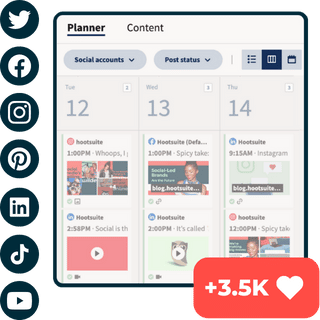
Schedule posts, talk to customers, and track your performance in one place. Grow your business faster with Hootsuite.
Start free 30-day trial4. Optimize for accessibility
Make sure your images are the right size
There’s nothing worse than visiting a social profile and seeing that the images look terrible, am I right?
At best, it makes your brand looks unprofessional. At worse, it makes it look spammy and fake.
Ensure that your profile picture is a high-resolution image that isn’t overly cropped, speaks to your brand (preferably a company logo), and clearly represents your business. You’ll also want your profile images to be consistent across all your social channels, too. Doing this will help your audience with brand recognition.
As for your feed and story images? Those have different dimensions depending on the social network.
If you’re planning on crossposting the same image to multiple networks, double-check our always-up-to-date cheat sheet for image sizes across networks and have multiple versions of your image ready to go ahead of time.

Pro tip: Using a social media management tool like Hootsuite can make it much easier to crosspost without making mistakes:
- compose your post in the publisher
- edit the text and images for individual networks
- preview how they look on those networks before posting
Add alt text descriptions to visual content
Not everyone experiences social media content the same way.
Accessible visual content on social media can include:
- Alt-text descriptions. Alt-text allows visually-impaired users to appreciate images. Facebook, Twitter, LinkedIn, and Instagram now provide fields for alt-text image descriptions. Here are some tips for writing descriptive alt-text.
- Subtitles. All social videos should include captions. Not only are they crucial for hearing-impaired viewers, they help in sound-off environments as well. Language learners also benefit from subtitles. Plus, people who watch videos with captions are more likely to remember what they saw.
- Descriptive transcripts. Unlike captions, these transcripts describe the important sights and sounds that aren’t spoken or obvious. Descriptive audio and live-described video are other options.
You can use Hootsuite to add alt text to social media images.
5. Optimize for overall performance
Take the time to look at your current social media performance and think about the following areas:
- Are you hitting your goals and objectives?
- Do your social media goals still align with your larger digital marketing strategy?
- Are you posting the right types of content? For example, images, videos, text-only, or a mixture of all three? (Hint, you want to aim for all three!)
- Are your posts resonating with your audience?
When thinking about the above points, consider how your social media optimization tactics will positively (or sometimes, negatively) impact them.
Of course, you can always view your performance data on the individual social networks’ native analytics dashboards. But if you want to compare the performance of your posts across all of your company’s social media channels, a social media analytics dashboard like the one offered by Hootsuite can help you more effectively.
A tool like this makes it easy to see where you should focus your social media optimization efforts next.
Are your engagement numbers down? Maybe it’s time to try some carousel posts? Is follower growth slowing down? Try optimizing your captions for SEO.
After, you can track the impact your efforts made in the same easy-to-use dashboard.
One social media optimization tool to do it all
Looking for a social media optimization tool that can help you improve your engagement, follower growth, conversions, accessibility, and overall performance? Hootsuite can help you do all of these things with the following features:
- Best times to post recommendations
- AI hashtag generator
- Scheduling for all different types of social media posts, including carousels and stories
- Social media post templates for when you run out of content ideas
- Image editor with dimensions per network
- Crossposting editing capabilities
- Monthly view content calendar
- Alt text for social media images
- Closed captioning for Twitter and Facebook videos
- Performance tracking for all major networks to see if your social media optimization efforts are working
Do it better with Hootsuite, the all-in-one social media toolkit. Stay on top of things, grow, and beat the competition.
Free 30-Day TrialThe post The Easiest Social Media Optimization Techniques to Try Now appeared first on Social Media Marketing & Management Dashboard.
Categories
- 60% of the time… (1)
- A/B Testing (2)
- Ad placements (3)
- adops (4)
- adops vs sales (5)
- AdParlor 101 (43)
- adx (1)
- algorithm (1)
- Analysis (9)
- Apple (1)
- Audience (1)
- Augmented Reality (1)
- authenticity (1)
- Automation (1)
- Back to School (1)
- best practices (2)
- brand voice (1)
- branding (1)
- Build a Blog Community (12)
- Case Study (3)
- celebrate women (1)
- certification (1)
- Collections (1)
- Community (1)
- Conference News (1)
- conferences (1)
- content (1)
- content curation (1)
- content marketing (1)
- contests (1)
- Conversion Lift Test (1)
- Conversion testing (1)
- cost control (2)
- Creative (6)
- crisis (1)
- Curation (1)
- Custom Audience Targeting (4)
- Digital Advertising (2)
- Digital Marketing (6)
- DPA (1)
- Dynamic Ad Creative (1)
- dynamic product ads (1)
- E-Commerce (1)
- eCommerce (2)
- Ecosystem (1)
- email marketing (3)
- employee advocacy program (1)
- employee advocates (1)
- engineers (1)
- event marketing (1)
- event marketing strategy (1)
- events (1)
- Experiments (21)
- F8 (2)
- Facebook (64)
- Facebook Ad Split Testing (1)
- facebook ads (18)
- Facebook Ads How To (1)
- Facebook Advertising (30)
- Facebook Audience Network (1)
- Facebook Creative Platform Partners (1)
- facebook marketing (1)
- Facebook Marketing Partners (2)
- Facebook Optimizations (1)
- Facebook Posts (1)
- facebook stories (1)
- Facebook Updates (2)
- Facebook Video Ads (1)
- Facebook Watch (1)
- fbf (11)
- first impression takeover (5)
- fito (5)
- Fluent (1)
- Get Started With Wix Blog (1)
- Google (9)
- Google Ad Products (5)
- Google Analytics (1)
- Guest Post (1)
- Guides (32)
- Halloween (1)
- holiday marketing (1)
- Holiday Season Advertising (7)
- Holiday Shopping Season (4)
- Holiday Video Ads (1)
- holidays (4)
- Hootsuite How-To (3)
- Hootsuite Life (1)
- how to (5)
- How to get Instagram followers (1)
- How to get more Instagram followers (1)
- i don't understand a single thing he is or has been saying (1)
- if you need any proof that we're all just making it up (2)
- Incrementality (1)
- influencer marketing (1)
- Infographic (1)
- Instagram (39)
- Instagram Ads (11)
- Instagram advertising (8)
- Instagram best practices (1)
- Instagram followers (1)
- Instagram Partner (1)
- Instagram Stories (2)
- Instagram tips (1)
- Instagram Video Ads (2)
- invite (1)
- Landing Page (1)
- link shorteners (1)
- LinkedIn (22)
- LinkedIn Ads (2)
- LinkedIn Advertising (2)
- LinkedIn Stats (1)
- LinkedIn Targeting (5)
- Linkedin Usage (1)
- List (1)
- listening (2)
- Lists (3)
- Livestreaming (1)
- look no further than the new yorker store (2)
- lunch (1)
- Mac (1)
- macOS (1)
- Marketing to Millennials (2)
- mental health (1)
- metaverse (1)
- Mobile App Marketing (3)
- Monetizing Pinterest (2)
- Monetizing Social Media (2)
- Monthly Updates (10)
- Mothers Day (1)
- movies for social media managers (1)
- new releases (11)
- News (73)
- News & Events (13)
- no one knows what they're doing (2)
- OnlineShopping (2)
- or ari paparo (1)
- owly shortener (1)
- Paid Media (2)
- People-Based Marketing (3)
- performance marketing (5)
- Pinterest (34)
- Pinterest Ads (11)
- Pinterest Advertising (8)
- Pinterest how to (1)
- Pinterest Tag helper (5)
- Pinterest Targeting (6)
- platform health (1)
- Platform Updates (8)
- Press Release (2)
- product catalog (1)
- Productivity (10)
- Programmatic (3)
- quick work (1)
- Reddit (3)
- Reporting (1)
- Resources (34)
- ROI (1)
- rules (1)
- Seamless shopping (1)
- share of voice (1)
- Shoppable ads (4)
- Skills (28)
- SMB (1)
- SnapChat (28)
- SnapChat Ads (8)
- SnapChat Advertising (5)
- Social (166)
- social ads (1)
- Social Advertising (14)
- social customer service (1)
- Social Fresh Tips (1)
- Social Media (5)
- social media automation (1)
- social media content calendar (1)
- social media for events (1)
- social media management (2)
- Social Media Marketing (49)
- social media monitoring (1)
- Social Media News (4)
- social media statistics (1)
- social media tracking in google analytics (1)
- social media tutorial (2)
- Social Toolkit Podcast (1)
- Social Video (5)
- stories (1)
- Strategy (626)
- terms (1)
- Testing (2)
- there are times ive found myself talking to ari and even though none of the words he is using are new to me (1)
- they've done studies (1)
- this is also true of anytime i have to talk to developers (1)
- tiktok (8)
- tools (1)
- Topics & Trends (3)
- Trend (12)
- Twitter (15)
- Twitter Ads (5)
- Twitter Advertising (4)
- Uncategorised (9)
- Uncategorized (13)
- url shortener (1)
- url shorteners (1)
- vendor (2)
- video (10)
- Video Ads (7)
- Video Advertising (8)
- virtual conference (1)
- we're all just throwing mountains of shit at the wall and hoping the parts that stick don't smell too bad (2)
- web3 (1)
- where you can buy a baby onesie of a dog asking god for his testicles on it (2)
- yes i understand VAST and VPAID (1)
- yes that's the extent of the things i understand (1)
- YouTube (13)
- YouTube Ads (4)
- YouTube Advertising (9)
- YouTube Video Advertising (5)


